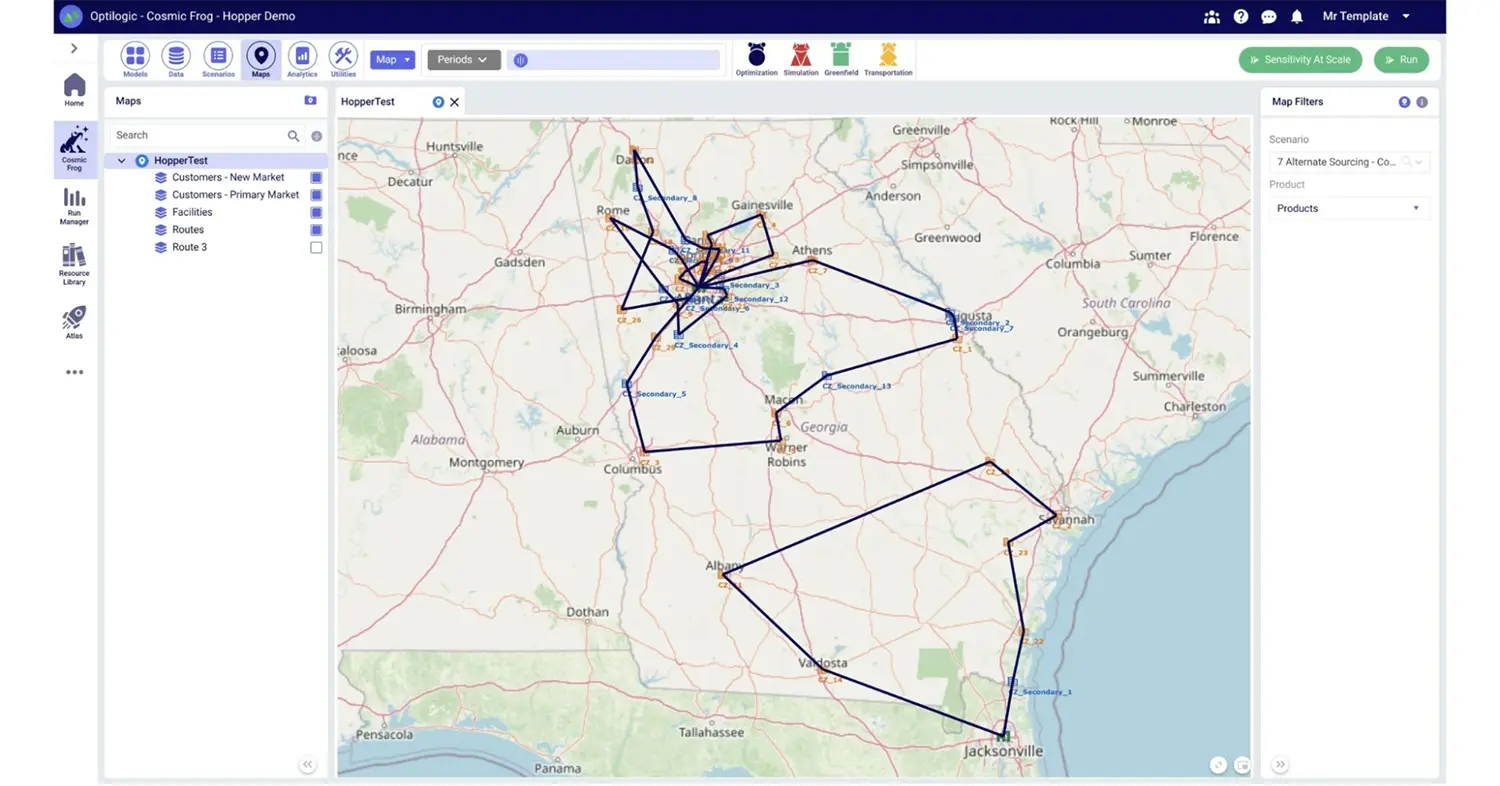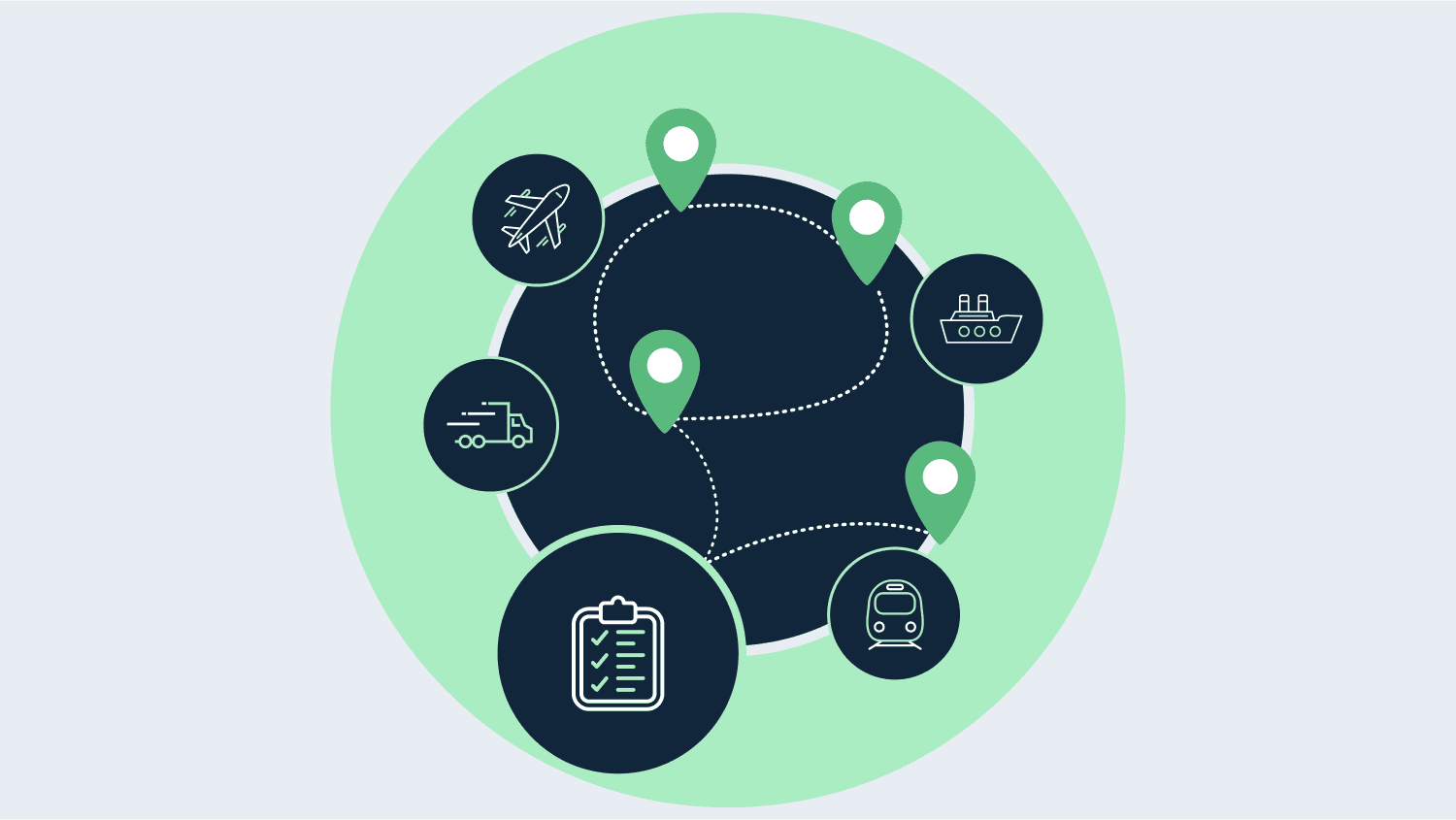Keeping your supply chain running smoothly is key to staying ahead for logistics supply chain companies. With so many moving parts, finding the right tools to keep everything in line can be a game-changer.
A survey by Gartner found that 85% of companies using network optimization tools to manage their supply chains got better and faster at their work, saved money by 20%, and made their customers happier.
We’ve explored the market to bring you the seven best supply chain network optimization tools designed to simplify, optimize, and transform your supply chain network. These tools are not just about keeping things moving; they’re about moving smarter, faster, and more efficiently.
Whether you’re looking to cut costs, boost efficiency, or just get a better overview of your operations, these tools are your ticket to a streamlined supply chain.
Now, let’s talk about the seven best supply chain network optimization models.
Quick Read: 8 Best Strategies to Consider For Your Logistics Network Optimization
1. Sophus X

Sophus X emerges as one of the best supply chain network optimization tools, engineered to meet the complex demands of modern global supply chains. Its development leverages cutting-edge mathematical languages and database technologies, ensuring businesses can navigate the complexities of supply chain management with unparalleled precision and efficiency.
Key Features
Integrated Business Planning
- Annual Budget Planning: Streamlines financial forecasting and aligns it with operational strategies.
- Long-Term Capacity Planning: Ensures infrastructure and resources meet future demand.
- Integrated Sales & Operations Planning (S&OP): Merges sales forecasts with production planning for balance.
- Distribution Planning: Optimizes the flow of goods to meet customer demands efficiently.
- Sourcing Plan: Develop strategies for procuring goods and services effectively.
Inventory Planning and Management
- Multi-Echelon Inventory Planning: Optimizes inventory across various levels in the supply chain.
- Aftermarket Spare Parts Inventory Planning: Balances stock levels for spare parts to meet service commitments.
- End-to-End Shelf-Life Simulation and Optimization: Manages and optimizes products’ shelf life across the supply chain.
- Raw Material and Intermediates Inventory Optimization: Ensures optimal levels of raw materials and intermediate goods.
- Replenishment Planning: Strategizes inventory replenishment to avoid stockouts and overstocks.
Supply Chain Network Design
- Site Selection: Identifies optimal locations for facilities based on various factors.
- Distribution Network Design: Plans the structure of the distribution network to enhance efficiency and reduce costs.
- Omni-Channel Supply Chain Network Design: Designs supply chains that seamlessly integrate multiple sales channels.
- Supply Chain Integration – Mergers & Acquisitions (M&A): Harmonizes supply chains of merged or acquired entities.
- Aftermarket Spare Parts Network Design: Creates efficient networks for distributing spare parts.
Operation Optimization
- Transportation Routes Planning: Identifies the most efficient and cost-effective transportation routes.
- Order-Shipment Assignment Optimization: Aligns orders with the best shipping options to maximize efficiency.
Sustainability
- GHG Emission Modeling: Assesses the carbon footprint of supply chain activities.
- GHG Emission Optimization: Identifies strategies to reduce greenhouse gas emissions throughout the supply chain.
Why Sophus X
Sophus X is a premier SaaS provider focused on revolutionizing supply chain network design tools and planning. Through the integration of advanced data modeling, AI/ML, optimization, and simulation technologies, it offers a comprehensive solution to enhance every facet of the supply chain, from procurement to customer fulfillment.
Sophus X also incorporates carbon offset calculation and optimization, underscoring a commitment to sustainability and operational excellence. Sophus offers tools for business planning, inventory control, and designing supply chains, ensuring real improvements and leading the way in making supply chain operations digital and more efficient.
Underneath, you will find a comprehensive overview of what is Sophus X brings to the table.

2. Coupa

Coupa is a comprehensive platform integrating supply chain management with financial oversight, designed for businesses looking to streamline their operations and financial flows concurrently.
Key Features
- Algorithm and Forecasting: Coupa’s optimization toolkit includes Greenfield Optimization, Network Optimization, Inventory Optimization, Transportation Optimization, Forecasting, and Supply Chain Management simulations, although it utilizes first-generation technologies, which may not offer Sophus’s efficiency or speed.
- Technology Foundation: Relying on earlier technology generations, Coupa provides reliability but may lag in processing speed compared to tools built on more modern foundations.
- ETL Capability: Coupa supports ETL data processing, but it lacks the seamless integration seen in Sophus, potentially complicating the data handling process.
- Unified Spend Management Platform: Coupa’s comprehensive spend management platform offers a unified solution for procurement, invoicing, and expense management, enabling businesses to gain visibility and control over their spending..
- Pricing: Positioned at a higher price point, Coupa’s comprehensive suite comes at a premium, which may impact its accessibility for smaller businesses or those with tight budgets.
3. Optilogic

Optilogic provides a customizable and flexible solution for supply chain optimization, built on Python, for businesses seeking tailored optimization processes.
Key Features
- Optimization Capabilities: Offers a range of optimization functionalities, including GF, NO, IO, TO, and Supply Chain Management simulations, albeit with the flexibility of Python, which may affect performance speed.
- Technological Flexibility: Python’s adaptability is a double-edged sword. It offers customization at the cost of potentially slower performance than Sophus’s latest technology stack
- Intuitive Interface and Analytics: The platform comes with an intuitive interface and robust analytics tools, providing users with clear insights into their supply chain operations and enabling data-driven decision-making.
- Scalable Cloud Infrastructure: With its cloud-native infrastructure, Optilogic offers scalable solutions that can adjust to the varying demands of businesses, ensuring high performance without the need for on-premise hardware.
- Pricing: Optilogic maintains competitive pricing, making it an accessible option for businesses prioritizing flexibility over out-of-the-box performance.
4. AIMMS
AIMMS is tailored for organizations that require highly customizable supply chain optimization solutions. It caters to businesses needing manual intervention in their optimization processes, offering a unique approach through SQL-based data management and specialized optimization features.
Key Features
- Specialized Optimization Features: AIMMS’s toolkit includes manual seeding for Greenfield Optimization and basic Inventory Optimization, which requires more hands-on input but allows for highly tailored solutions.
- SQL-Based Data Management: Utilizing SQL, AIMMS provides a well-understood but potentially less efficient data management system compared to Sophus’s modern and integrated approach.
- SC Navigator: This tool allows businesses to visualize and test various supply chain scenarios, helping them to understand the potential impacts of strategic decisions before implementing them. It’s designed to improve supply chain resilience and efficiency.
- Low Code Platform: This platform is accessible to users without deep technical expertise, enabling the quick development and deployment of optimization models. This democratizes the use of advanced analytics in decision-making processes.
- Pricing: AIMMS is positioned at a higher price point, similar to Coupa, which might limit its accessibility for smaller businesses or those with budget constraints.
5. Logistics Pro
Logistics Pro offers an analytics-driven approach to supply chain optimization, providing businesses with deep insights for strategic decision-making. It leverages big data analytics and machine learning to forecast demand, optimize inventory levels, and recommend efficient transportation routes.
Key Features
- Data-Driven Insights: Utilizes big data analytics and machine learning to provide actionable insights for supply chain optimization.
- Demand Forecasting: Employs advanced algorithms for accurate demand prediction, helping businesses adjust their inventory and production plans accordingly.
- Transportation Optimization: Recommends the most efficient routes and transportation modes, reducing costs and improving delivery times.
- Scalable Solution: Designed to grow with your business, Logistics Pro can easily handle increasing data volumes and complexity.
- User-Friendly Interface: Offers a clean, intuitive interface that simplifies the complex analytics into actionable insights for decision-makers.
6. Supply Chain 360
Supply Chain 360 offers an integrated supply chain management solution that seamlessly connects with Enterprise Resource Planning (ERP) systems, providing a unified view of supply chain and business operations. It’s designed for businesses looking to optimize their supply chain and overall business processes.
Key Features
- ERP Integration: Seamless connection with ERP systems for a unified operational view.
- Inventory Management: Advanced inventory optimization algorithms help reduce excess stock and out-of-stocks.
- Supplier Collaboration: Facilitates real-time collaboration with suppliers for improved efficiency and reduced costs.
- Customizable Dashboards: Offers customizable dashboards and reports for a tailored analytical view of the supply chain operations.
- Cloud-Based: A fully cloud-based solution, ensuring accessibility and scalability without the need for on-premise infrastructure.
7. Inventory IQ
Inventory IQ is a cutting-edge supply chain modeling tool that optimizes inventory levels across various industries. By leveraging artificial intelligence (AI) and machine learning, Inventory IQ predicts demand fluctuations with high accuracy, ensuring optimal stock levels at all times.
Key Features
- AI-Powered Demand Forecasting: This method utilizes advanced AI algorithms to predict demand with precision, helping businesses avoid overstocking or stockouts.
- Automated Replenishment Recommendations: Generates automatic replenishment orders based on forecasted demand, current inventory levels, and lead times, ensuring optimal inventory at all times.
- Inventory Health Analytics: Offers detailed insights into inventory performance, identifying slow-moving items and recommending corrective actions.
- Integration Capabilities: Seamlessly integrates with existing ERP and SCM systems, providing a holistic view of inventory management within the broader supply chain operations.
- Scalability: Designed to scale with your business, Inventory IQ can handle growing inventory volumes and complexity without a hitch.
What to Look for When Choosing Supply Chain Network Design Tools
Selecting the appropriate tools for supply chain network design is pivotal for organizations aiming to optimize their supply chain efficiency, reduce costs, and enhance service levels. Here’s a detailed guide on what to consider:
1. Data Integration
The foundation of effective network design lies in accurate and reliable data.
What to look for:
- Compatibility: The tool should seamlessly integrate with existing systems (ERP, CRM, WMS, etc.), facilitating easy access, import, and data update.
- Data Handling: It must handle diverse data formats, standards, and qualities, ensuring smooth data preparation and integration processes.
- Real-Time Updates: Capability for real-time data synchronization to reflect current operational realities in the network design.=
2. Modeling Capabilities
Modeling capabilities of supply chain network optimization tools determine their effectiveness in reflecting the complexities of your supply chain network design.
What to look for:
- Flexibility: The ability to model various network structures, parameters, constraints, and objectives tailored to specific business needs.
- Complexity Management: Tools should be adept at capturing the dynamics and intricacies of supply chains, including multi-echelon networks.
- Customization: Options for adjusting models based on changing requirements, preferences, and scenarios.
3. Optimization Algorithms
Optimization algorithms are crucial for identifying efficient, cost-effective, and sustainable network designs.
What to look for:
- Advanced Algorithms: Look for linear programming, mixed-integer programming, heuristic methods, and other sophisticated algorithms.
- Goal Alignment: The tool should offer algorithms that align with your specific optimization goals (cost minimization, service level maximization, etc.).
- Scalability and Efficiency: Capability to handle large-scale optimization problems efficiently, offering optimal or near-optimal solutions within reasonable time frames.
4. Scenario Analysis
Scenario analysis capabilities enable organizations to assess the impact of various changes and uncertainties on their network design.
What to look for:
- What-If Scenarios: Tools should allow for the exploration of different scenarios, including demand fluctuations, supply disruptions, and cost variations.
- Sensitivity Analysis: Capability to identify which variables have the most significant impact on the network’s performance.
- Stress Testing: Assess the network’s resilience under extreme conditions, ensuring preparedness for unforeseen challenges.
5. Visualization and Reporting
Adequate visualization and reporting are vital for interpreting, communicating, and making informed decisions based on network design analyses.
What to look for:
- Diverse Visualization Tools: Maps, graphs, charts, tables, and dashboards that offer clear insights into network design outcomes.
- Custom Reporting: Options for creating custom reports that cater to specific stakeholder needs and preferences.
- Interactivity: Interactive visualization and reporting features that allow users to drill down into the data for deeper analysis.
6. User Interface and Support
A user-friendly interface and comprehensive support system are essential for maximizing the tool’s utility and ensuring smooth operation.
What to look for:
- Intuitive Design: An interface that is easy to navigate for users at all skill levels, reducing the learning curve and increasing productivity.
- Comprehensive Support: Access to manuals, tutorials, FAQs, forums, and responsive customer service to help users overcome any hurdles in using the tool.
- Community and Resources: A strong user community and access to a wealth of resources can be invaluable for sharing best practices and insights.
7. Data Security
Ensuring robust data security measures is paramount when selecting design software, particularly in environments where sensitive information is handled.
What to look for:
- ISO27001 Certification: Look for software that adheres to ISO27001 standards for product development and data security. This certification signifies that the software has implemented rigorous protocols to safeguard data integrity and confidentiality.
- On-Premise Implementation: Some clients may require enhanced data security and prefer to isolate their systems from the Internet. In such cases, opt for software that supports on-premise implementation.
- Ease of Implementation and Maintenance: Choose a solution that offers seamless integration into existing systems and workflows, minimizing disruptions and reducing the burden of maintenance tasks.
Conclusion: Elevating Supply Chain Management with Sophus X
Today’s global supply chains require a tool that not only meets your current needs but also prepares you for what’s ahead. While we’ve explored various options for supply chain network optimization tools, Sophus X stands out for its powerful features. It’s more than just software; it’s a complete system for planning your business better, managing your inventory smarter, and designing your supply chain more effectively.
Sophus X is ideal for those who need to navigate the complex world of supply chains with ease and precision. It’s recognized for its excellence in supply chain network optimization tools, making operations smoother for businesses of all sizes.
An insightful demo is available for anyone interested in taking their supply chain operations to the next level. See how Sophus X can make a difference in your business today.









